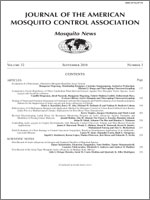Three exotic mosquito-borne pathogens—dengue, chikungunya, and Zika viruses—transmitted by Aedes albopictus and Ae. aegypti have undergone dramatic global expansion in recent years. The control of vector populations and minimizing bites from these vectors are the primary methods of reducing risk of transmission of these viruses to humans. However, Ae. albopictus and Ae. aegypti are notoriously challenging to control through conventional chemical means, due primarily to difficulties in applying pesticides to their cryptic larval habitats. A novel strategy for suppressing populations of these species is the autodissemination of insect growth regulators (IGRs), in which adult female mosquitoes are attracted to a treatment station where they are tainted with small amounts of potent IGR. When the adult females subsequently visit oviposition sites, they inadvertently disseminate the IGR to larval development sites, suppressing their own population. Implementing this technology to control natural vector populations presents substantial logistical challenges. The current manuscript describes laboratory bioassays and field evaluations to design a novel autodissemination station (ADS) and test the methodology at field locations in Florida where Ae. aegypti and Ae. albopictus are abundant and pose a risk for transmission of emerging pathogens. The prototype ADS is intended to attract host-seeking, resting site–seeking, and oviposition site–seeking females through a combination of visual and olfactory cues. The efficacy of this strategy was assessed through the use of sentinel ovicups at field locations in Indian River County and Martin County, FL. Greatest efficacy (45.3 ± 7.7% mortality in treatment sentinel ovicups) was achieved at a field site with few competing natural ovisites, while much lower efficacy was observed in locations with numerous competing ovisites (0.0 to 29.0 ± 8.2% mortality). The efficacy of the ADS is likely to be strongly affected by the abundance of competing ovisites, the population dynamics, and climatic conditions.
How to translate text using browser tools
1 September 2016
Testing of Visual and Chemical Attractants in Correlation with the Development and Field Evaluation of an Autodissemination Station for the Suppression of Aedes aegypti and Aedes albopictus in Florida
Mark A. Kartzinel,
Barry W. Alto,
Michael W. Deblasio II,
Nathan D. Burkett-Cadena
ACCESS THE FULL ARTICLE
It is not available for individual sale.
This article is only available to subscribers.
It is not available for individual sale.
It is not available for individual sale.
Aedes aegypti
Aedes albopictus
autodissemination
Chikungunya virus
dengue virus
pyriproxyfen
Zika virus





